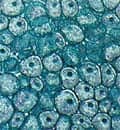Researchers have discovered a novel component of the influenza virus that may be the key to disabling the virus’s ability to replicate itself and to developing a universal antiviral treatment. The findings were published in Proceedings of the National Academy of Sciences.
The influenza A virus is encoded by eight individual single-stranded segments of RNA. Each segment must serve as the material for making both protein and new segments, processes called transcription and replication. As each strand must perform both functions, it is imperative that the virus prioritize these processes, starting with transcription and then switching to replication.
For the first time, researchers identified a small-viral RNA (svRNA), derived from the virus, that is integral to the switch from transcription to replication. Inhibiting svRNA from making the switch would stymie replication and thus slow or halt the spread of the virus. Because segment ends and replication strategies used for influenza B and C are similar to those of influenza A, this discovery can lead to a universal treatment for people suffering from the disease. It would also be effective against the H1N1 swine flu virus.
Source: EurekAlert









